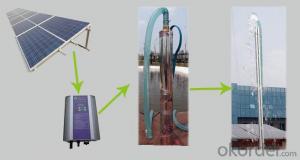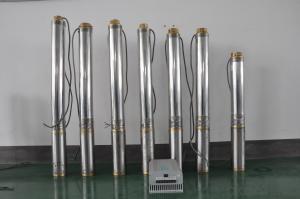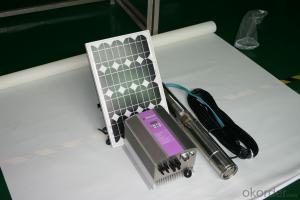Solar Water Pumping Solar Power Pumps Submersible Pump
- Loading Port:
- Shanghai
- Payment Terms:
- TT OR LC
- Min Order Qty:
- 1 set
- Supply Capability:
- 1000 set/month
OKorder Service Pledge
OKorder Financial Service
You Might Also Like
Solar Water Pumping Solar Power Pumps Submersible Pump
DC solar water pumping system consists of the motor, pump, controller, solar array and some other accessories, such as water level sensor, float switch, etc. Considered that storing water is more efficient than storing electricity, the system is designed to directly drive the pump without battery which can reduce the construction and operating cost and routine maintenance effectively.The PV array consists of multiple solar panels connected in series/parallel, which can supply the whole system as power source by converting the absorbed solar radiation energy to the electrical energy. The pump driven by a brushless DC permanent magnet motor draws water from deep-well or river. The pumped water is then fed into reservoir or water tank, or connected to the irrigation system or fountain system directly.
Advanced Technology
Applications Innovation
The efficiency of DC brushless permanent magnet motor has been increased up to 25% in comparison with traditional asynchronous motor.
Technology Innovation
Stator and rotor are sealed by environment friendly casting resin.Motor insulation resistance can be hold higher than 300MΩfor more than 10 years, which consumedly increased the security and reliability of the submersible motor.
Structure Innovation
Casting resign technology processed stator and rotor as well as the water lubricated bearing make the submersible pump environment friendly.
Feature
High Efficiency & High Reliability
DC Brushless Permanent Magnet Motor
Minimum Maintenance, long Service Life
Environment Friendly Materials, Lubricated Without Oil
Application
Village or Family Water Supply
Animal Drinking Water & Livestock Watering
Garden/Courtyard Irrigation
Swimming Pool
Water Supply for Bivouac or Camping Car
Water Supply for Remote Area
Automatic Control
Operate Automatically, No Need Watching
Maximum Power Point Tracking (MPPT)
Dry-run Protection
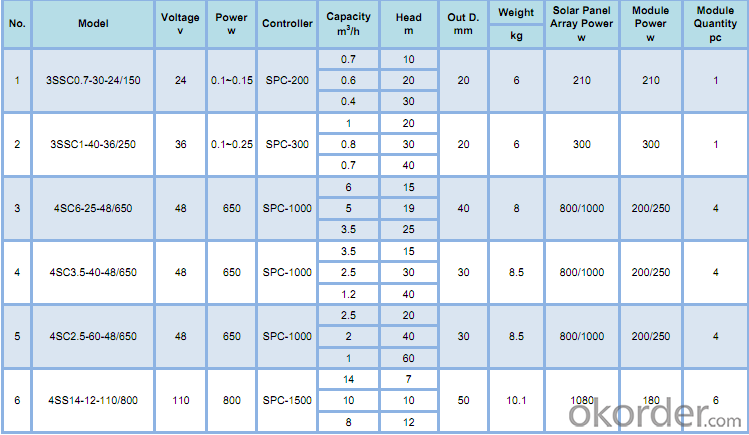
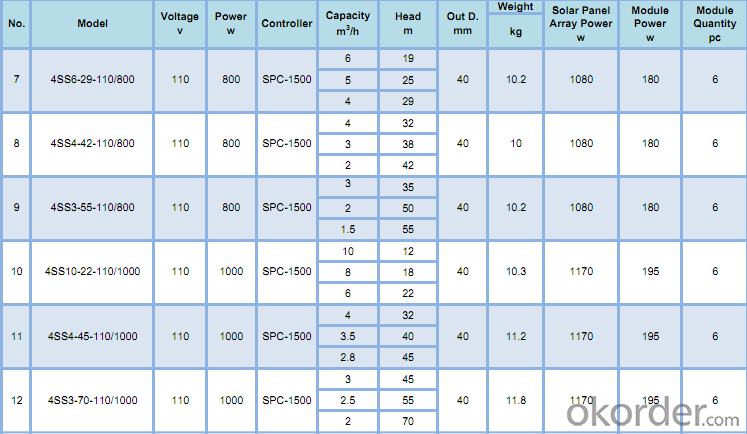
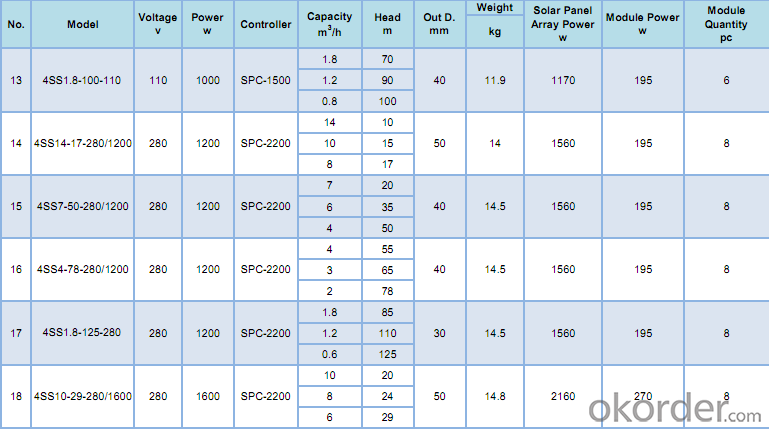
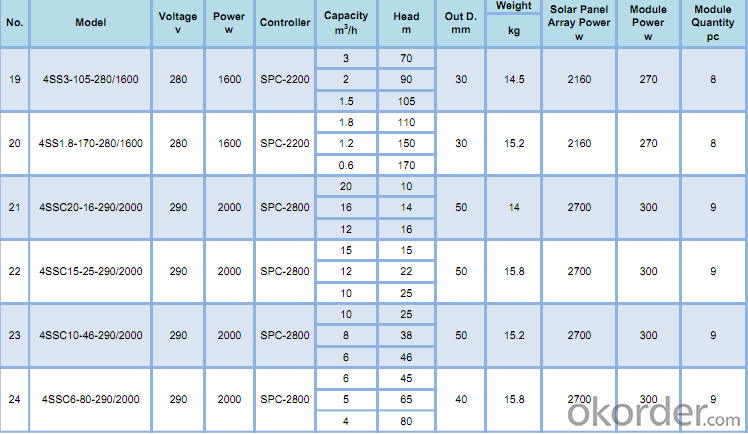

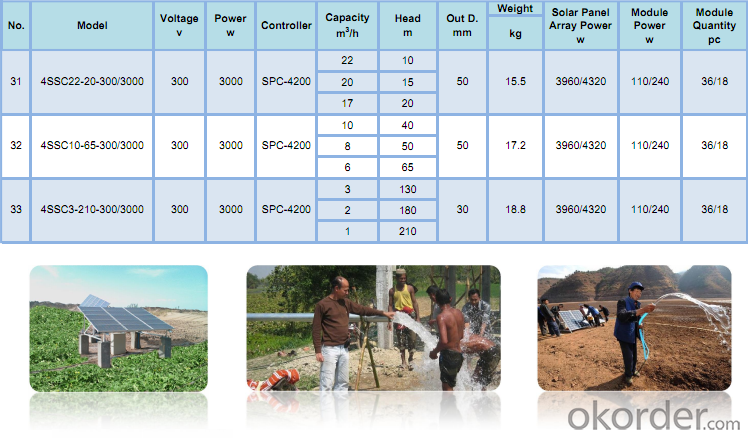
- Q:How do I properly size the solar array for a solar pump system?
- To properly size a solar array for a solar pump system, there are several factors to consider. Firstly, you need to determine the total power consumption of your pump system. This includes the power required to run the pump itself, as well as any additional accessories or equipment such as controllers or sensors. It is important to consider the peak power demand of the pump system to ensure that your solar array can meet the requirements even during periods of high demand. Next, you should assess the solar resource available at the installation site. This includes factors such as the average daily sunlight hours, the solar irradiance, and any shading or obstructions that may affect the solar panels. This information can be obtained from solar maps or local meteorological data. Once you have determined the power consumption and solar resource, you can calculate the size of the solar array needed. The basic formula is: Solar Array Size (in watts) = Power Consumption (in watts) / Solar Resource (in watts per square meter) For example, if your pump system consumes 1000 watts and the solar resource at your location is 200 watts per square meter, you would need a solar array of 5 square meters (1000 watts / 200 watts per square meter). It is also important to consider system losses and inefficiencies when sizing the solar array. These losses can be due to factors such as temperature, wiring, and inverter efficiency. To account for these losses, it is recommended to multiply the calculated solar array size by a factor of 1.25 to 1.5. Additionally, you may want to consider the battery storage capacity for your solar pump system. This will ensure that you have sufficient power during periods of low sunlight or at night. The battery capacity should be determined based on the amount of power required during these periods, and it should be sized to provide enough energy storage to meet your specific needs. Overall, properly sizing the solar array for a solar pump system requires careful consideration of the power consumption, solar resource, system losses, and battery storage capacity. It is recommended to consult with a solar professional or installer to ensure accurate calculations and optimal performance for your specific application.
- Q:Can a solar pump be used to pump oil or gas?
- No, a solar pump is not typically used to pump oil or gas. Solar pumps are primarily designed to pump water or other fluids that are not as dense or viscous as oil or gas.
- Q:How does a solar pump handle fluctuations in water quality?
- A solar pump can handle fluctuations in water quality quite effectively. The pump itself is not directly affected by changes in water quality. However, it is important to note that the pump's performance can indirectly be influenced by factors such as sediment, debris, or contaminants in the water. To mitigate these issues, solar pumps often include filters and other water treatment systems to prevent clogging or damage. Regular maintenance and cleaning of these components are necessary to ensure optimal operation and longevity of the pump.
- Q:Can a solar pump be used for water supply in remote campgrounds?
- Yes, a solar pump can be used for water supply in remote campgrounds. Solar pumps are an excellent choice for off-grid locations as they utilize solar energy to power the pump, eliminating the need for electricity. This makes them highly suitable for remote areas where access to power sources may be limited or non-existent. Solar pumps are reliable, energy-efficient, and can provide a sustainable water supply solution for remote campgrounds.
- Q:Can a solar pump be used in commercial car wash facilities?
- Yes, a solar pump can be used in commercial car wash facilities. Solar pumps are an eco-friendly and cost-effective solution for water pumping needs, making them a suitable choice for businesses focused on sustainability. Solar pumps use energy from the sun to power the pump, eliminating the need for grid electricity or diesel generators. They can be used for various applications in car wash facilities, such as water circulation, pressure washing, and filling water tanks. Additionally, solar pumps can help reduce operational costs by minimizing energy expenses and maintenance requirements. However, it is important to consider the specific requirements of the car wash facility and ensure that the solar pump chosen has the capacity and capabilities needed for the facility's water pumping needs.
- Q:Can a solar pump be used in areas with high wind conditions?
- Yes, a solar pump can be used in areas with high wind conditions. However, it is important to consider the stability and durability of the installation to ensure that the pump remains secure and functional in such conditions. Additionally, proper design and anchoring techniques should be implemented to minimize any potential damage caused by the strong winds.
- Q:Can a solar pump be used for water supply in off-grid hospitals?
- Yes, a solar pump can be used for water supply in off-grid hospitals. Solar pumps are a sustainable and reliable solution that can provide a constant and clean water supply without the need for grid electricity. They can be easily installed in remote areas and operate efficiently using solar energy, making them ideal for off-grid hospitals that lack consistent access to electricity.
- Q:Can a solar pump be used to fill a water storage tank?
- Yes, a solar pump can be used to fill a water storage tank. Solar pumps use solar energy to power the pump, allowing it to draw water from a source such as a well or a river, and then pump it into a storage tank. This is an environmentally-friendly and cost-effective method of filling a water storage tank, as it eliminates the need for electricity or fuel to power the pump. Additionally, solar pumps can be used in remote areas where access to electricity may be limited or nonexistent.
- Q:Can a solar pump be used for water supply in parks or recreational areas?
- Yes, a solar pump can be used for water supply in parks or recreational areas. Solar pumps are an efficient and sustainable solution for water supply in outdoor spaces. They harness solar energy to power the pump, eliminating the need for electricity and reducing costs. Additionally, solar pumps are environmentally friendly and can provide a reliable water source for various recreational purposes such as irrigation, decorative water features, and drinking water supply.
- Q:How much water can a solar pump deliver?
- The amount of water a solar pump can deliver depends on various factors such as the size and capacity of the pump, the intensity of sunlight, and the efficiency of the system. Generally, solar pumps have the capability to deliver several thousand gallons of water per day, but it is important to consider specific pump specifications and local environmental conditions to determine the precise capacity.
1. Manufacturer Overview |
|
|---|---|
| Location | |
| Year Established | |
| Annual Output Value | |
| Main Markets | |
| Company Certifications | |
2. Manufacturer Certificates |
|
|---|---|
| a) Certification Name | |
| Range | |
| Reference | |
| Validity Period | |
3. Manufacturer Capability |
|
|---|---|
| a)Trade Capacity | |
| Nearest Port | |
| Export Percentage | |
| No.of Employees in Trade Department | |
| Language Spoken: | |
| b)Factory Information | |
| Factory Size: | |
| No. of Production Lines | |
| Contract Manufacturing | |
| Product Price Range | |
Send your message to us
Solar Water Pumping Solar Power Pumps Submersible Pump
- Loading Port:
- Shanghai
- Payment Terms:
- TT OR LC
- Min Order Qty:
- 1 set
- Supply Capability:
- 1000 set/month
OKorder Service Pledge
OKorder Financial Service
Similar products
New products
Hot products
Hot Searches
Related keywords
